» posted on Friday, May 3rd, 2013 by Linda Lou Burton
Two Hoosier Guys
 Linda Burton posting from Indianapolis, Indiana – An unopened letter under glass. A hat and cane on the bed. These lonely mementos are remnants of the lives of two men whose words have touched virtually every school child and avid reader of the last hundred years. I’m talking about James Whitcomb Riley (1849-1916) and Kurt Vonnegut Jr (1922-2007), both with inextricable ties to Indianapolis. Riley was an American writer known as the Hoosier Poet. His work tended to be humorous or sentimental and most of the thousand poems he published were in dialect, like Little Orphant Annie (1885). Vonnegut was an American writer known for his unique blend of satire and science fiction. His black comic voice became his trademark in novels such as Slaughterhouse Five (1969). The James Whitcomb Riley Museum Home and the Kurt Vonnegut Memorial Library sit only blocks apart in downtown Indianapolis. I visited both today, looking for more personal glimpses of the men and hoping to better understand what led them down their
Linda Burton posting from Indianapolis, Indiana – An unopened letter under glass. A hat and cane on the bed. These lonely mementos are remnants of the lives of two men whose words have touched virtually every school child and avid reader of the last hundred years. I’m talking about James Whitcomb Riley (1849-1916) and Kurt Vonnegut Jr (1922-2007), both with inextricable ties to Indianapolis. Riley was an American writer known as the Hoosier Poet. His work tended to be humorous or sentimental and most of the thousand poems he published were in dialect, like Little Orphant Annie (1885). Vonnegut was an American writer known for his unique blend of satire and science fiction. His black comic voice became his trademark in novels such as Slaughterhouse Five (1969). The James Whitcomb Riley Museum Home and the Kurt Vonnegut Memorial Library sit only blocks apart in downtown Indianapolis. I visited both today, looking for more personal glimpses of the men and hoping to better understand what led them down their 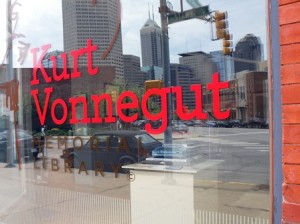 chosen paths. I never thought of them as anything alike, but before the day was over, I found that I was wrong; they had a great deal in common. Though born in different centuries, they grew up on Indiana time; little boys raised with Indiana values. As with most of us, they were greatly influenced by their families. James was the third of the six children of Reuben and Elizabeth Riley; Kurt Jr was the youngest of three children born to Kurt and Edith Vonnegut. Both families suffered a traumatic change of circumstances that reflected forever in the writings, and behaviors, of these two men.
chosen paths. I never thought of them as anything alike, but before the day was over, I found that I was wrong; they had a great deal in common. Though born in different centuries, they grew up on Indiana time; little boys raised with Indiana values. As with most of us, they were greatly influenced by their families. James was the third of the six children of Reuben and Elizabeth Riley; Kurt Jr was the youngest of three children born to Kurt and Edith Vonnegut. Both families suffered a traumatic change of circumstances that reflected forever in the writings, and behaviors, of these two men.
The trauma for James. The year before James was born in Greenfield, Indiana his father, an attorney, was elected to the Indiana House of Representatives and became friends with the governor, James Whitcomb. Just after James was born the family moved into a large house  on the National Road where he lived the idyllic life of swimming in the creek and climbing trees and telling ghost stories after dark. His father Reuben was in demand for his extraordinary political speeches; with father’s law office in their home James met many interesting visitors. Mother Elizabeth was a poet and lively storyteller who taught James to read and write before he went to public school. In 1861 when James was 12, Reuben enlisted in the Union Army; he returned from the Civil War partially paralyzed. The war had a negative physiological effect on him; he was unable to continue his legal practice and the family fell into financial distress. The family home had to be sold in April 1870 and Elizabeth died of heart disease in August. James and his father had a break in their relationship then; Reuben did not support James’ interest in poetry and writing; he wanted him to pursue a career in law. James blamed his father for his mother’s death and the loss of his childhood home. Over the years, James frequently wrote of how his peaceful life was cruelly snatched from him by war, poverty, and the loss of his mother. He struggled with alcohol addiction for the rest of his life.
on the National Road where he lived the idyllic life of swimming in the creek and climbing trees and telling ghost stories after dark. His father Reuben was in demand for his extraordinary political speeches; with father’s law office in their home James met many interesting visitors. Mother Elizabeth was a poet and lively storyteller who taught James to read and write before he went to public school. In 1861 when James was 12, Reuben enlisted in the Union Army; he returned from the Civil War partially paralyzed. The war had a negative physiological effect on him; he was unable to continue his legal practice and the family fell into financial distress. The family home had to be sold in April 1870 and Elizabeth died of heart disease in August. James and his father had a break in their relationship then; Reuben did not support James’ interest in poetry and writing; he wanted him to pursue a career in law. James blamed his father for his mother’s death and the loss of his childhood home. Over the years, James frequently wrote of how his peaceful life was cruelly snatched from him by war, poverty, and the loss of his mother. He struggled with alcohol addiction for the rest of his life.
The trauma for Kurt. Kurt Jr was born in Indianapolis to third generation German-American parents Kurt Sr and Edith. His father was one of the most prominent architects in the city; his mother was the daughter of a wealthy Indianapolis brewer. Kurt was the youngest of their 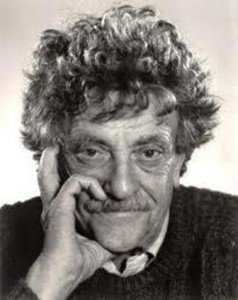 three children; his sister was Alice, his brother Bernard. Both Kurt’s father and grandfather Bernard had attended MIT; great-grandfather Clemens founded Vonnegut Hardware, an institution in the city. When the Depression hit, the architectural business began to fail; the family home had to be sold and Kurt was taken out of private school. Such a radical change in circumstances profoundly affected Kurt’s parents; Kurt Sr virtually gave up on life; Edith became addicted to prescription drugs and alcohol. Kurt Jr graduated from Shortridge High School in May 1940 and headed for Cornell that fall. While a student there, he enlisted in the US Army, a decision that displeased and worried his parents; he was on leave in Indianapolis when his mother died from an overdose of sleeping pills; it was Mother’s Day, 1944. Kurt was shipped to Europe soon after; he was captured by the Germans on December 19 at the Battle of the Bulge and imprisoned at Dresden, where he lived through the February 1945 firebombing that killed 60,000 civilians. As a POW he was given the grisly task of gathering corpses and burying the dead; in May he was liberated by Red Army troops and returned home. Awarded a Purple Heart for what he called “a ludicrously negligible wound,” he was left with a lifelong pessimism.
three children; his sister was Alice, his brother Bernard. Both Kurt’s father and grandfather Bernard had attended MIT; great-grandfather Clemens founded Vonnegut Hardware, an institution in the city. When the Depression hit, the architectural business began to fail; the family home had to be sold and Kurt was taken out of private school. Such a radical change in circumstances profoundly affected Kurt’s parents; Kurt Sr virtually gave up on life; Edith became addicted to prescription drugs and alcohol. Kurt Jr graduated from Shortridge High School in May 1940 and headed for Cornell that fall. While a student there, he enlisted in the US Army, a decision that displeased and worried his parents; he was on leave in Indianapolis when his mother died from an overdose of sleeping pills; it was Mother’s Day, 1944. Kurt was shipped to Europe soon after; he was captured by the Germans on December 19 at the Battle of the Bulge and imprisoned at Dresden, where he lived through the February 1945 firebombing that killed 60,000 civilians. As a POW he was given the grisly task of gathering corpses and burying the dead; in May he was liberated by Red Army troops and returned home. Awarded a Purple Heart for what he called “a ludicrously negligible wound,” he was left with a lifelong pessimism.
Despite the darkness in their lives, or, perhaps, because of it, both men rose to fame and prominence.
 James died a millionaire; during the 1880’s he became famous for his poetry reading tours, traveling the Midwest circuit first, and then nationally, making appearances with other famous talents such as Mark Twain and Bill Nye at a time when authors were treated like rock stars, with crowds clamoring to hear their poems and stories. He became a best-selling author in the 1890’s; his children’s poems were compiled into a book titled Rhymes of Childhood; it sold millions of copies and
James died a millionaire; during the 1880’s he became famous for his poetry reading tours, traveling the Midwest circuit first, and then nationally, making appearances with other famous talents such as Mark Twain and Bill Nye at a time when authors were treated like rock stars, with crowds clamoring to hear their poems and stories. He became a best-selling author in the 1890’s; his children’s poems were compiled into a book titled Rhymes of Childhood; it sold millions of copies and  has remained in print continually since 1912. When James stopped touring and settled down, he did so at 528 Lockerbie Street in Indianapolis, as houseguest of the Nickum and Holstein families, where he spent the remaining 23 years of his life. He never married and late in life began to regret having no children of his own. He became a doting uncle, showering gifts on his nieces and nephews; in 1893 he purchased the childhood home in Greenfield that had been
has remained in print continually since 1912. When James stopped touring and settled down, he did so at 528 Lockerbie Street in Indianapolis, as houseguest of the Nickum and Holstein families, where he spent the remaining 23 years of his life. He never married and late in life began to regret having no children of his own. He became a doting uncle, showering gifts on his nieces and nephews; in 1893 he purchased the childhood home in Greenfield that had been 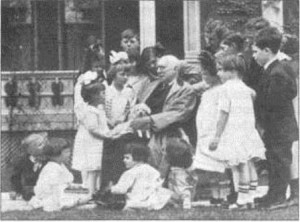 lost, and allowed his widowed sisters and their daughters to live there, providing for all their needs. The boarding home on Lockerbie Street became a destination for local schoolchildren; James recited poetry to them, and told stories, earning him the nickname “Children’s Poet.” Some of his best-loved writing recalls childhood in Indiana at a time when boys spent their days fishing, stealing watermelons and playing in the woods.
lost, and allowed his widowed sisters and their daughters to live there, providing for all their needs. The boarding home on Lockerbie Street became a destination for local schoolchildren; James recited poetry to them, and told stories, earning him the nickname “Children’s Poet.” Some of his best-loved writing recalls childhood in Indiana at a time when boys spent their days fishing, stealing watermelons and playing in the woods.
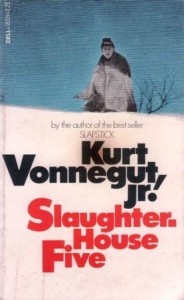 Kurt became a major voice in American literature, lauded for his sharp portrayal of modern society. The attainment and loss of the American Dream was the theme of much of what he wrote; his work often expressed the feelings of loneliness and despair that result from the disintegration of family. Family was vitally important to Kurt; he married his childhood sweetheart Jane Cox and together they raised three children; he also adopted three nephews when his beloved sister Alice and her husband died within days of each other. He experienced the pain of divorce; yet he remarried at age 57; he and photographer Jill Krementz adopted a daughter. His well-known phrase “So it goes” originated in his novel
Kurt became a major voice in American literature, lauded for his sharp portrayal of modern society. The attainment and loss of the American Dream was the theme of much of what he wrote; his work often expressed the feelings of loneliness and despair that result from the disintegration of family. Family was vitally important to Kurt; he married his childhood sweetheart Jane Cox and together they raised three children; he also adopted three nephews when his beloved sister Alice and her husband died within days of each other. He experienced the pain of divorce; yet he remarried at age 57; he and photographer Jill Krementz adopted a daughter. His well-known phrase “So it goes” originated in his novel  Slaughterhouse Five, a novel he felt compelled to write, based on his POW experience during WWII. It catapulted his following from that of “college student cult” to mass audiences; by the early 1970’s he was one of the most famous living writers on earth. As a citizen he was a lifelong supporter of the American Civil Liberties Union, known for his humanist
Slaughterhouse Five, a novel he felt compelled to write, based on his POW experience during WWII. It catapulted his following from that of “college student cult” to mass audiences; by the early 1970’s he was one of the most famous living writers on earth. As a citizen he was a lifelong supporter of the American Civil Liberties Union, known for his humanist 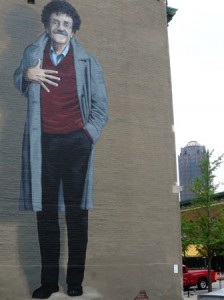 beliefs. “I am a humanist,” he said, “which means, in part, that I have tried to behave decently without expectations of rewards or punishments after I am dead.” Although he lived on the east coast for most of his adult life, he remained attached to Indianapolis. “Where is home?” he wrote in 2005. “I’ve wondered where home is, and I realized, it’s not Mars or someplace like that, it’s Indianapolis when I was nine years old. I had a brother and a sister, a cat and a dog, and a mother and a father and uncles and aunts. And there’s no way I can get there again.”
beliefs. “I am a humanist,” he said, “which means, in part, that I have tried to behave decently without expectations of rewards or punishments after I am dead.” Although he lived on the east coast for most of his adult life, he remained attached to Indianapolis. “Where is home?” he wrote in 2005. “I’ve wondered where home is, and I realized, it’s not Mars or someplace like that, it’s Indianapolis when I was nine years old. I had a brother and a sister, a cat and a dog, and a mother and a father and uncles and aunts. And there’s no way I can get there again.”
James died on July 22, 1916 from complications of a stroke. His body was taken to the Indiana State House were 35,000 people paid their last respects in a six-hour period. Kurt died on April 11, 2007 after a fall on the steps of his New York brownstone. He was mourned the world over as one of the great American writers of the 20th Century. Their legacy continues.
 The unopened letter under glass? Addressed to Kurt at his military address, it was written by his father, postmarked November 27, 1944. Penciled on the front is the word “MISSING” with the date 1-7-45, the time when Kurt was a POW imprisoned in an underground meat locker in Dresden. It was returned to Kurt’s father and eventually given to Kurt after his Army discharge; he chose never to open it. You can see the letter in a display case at the Kurt Vonnegut Memorial Library. Read more about Kurt and the writing programs going on today @ http://www.vonnegutlibrary.org/
The unopened letter under glass? Addressed to Kurt at his military address, it was written by his father, postmarked November 27, 1944. Penciled on the front is the word “MISSING” with the date 1-7-45, the time when Kurt was a POW imprisoned in an underground meat locker in Dresden. It was returned to Kurt’s father and eventually given to Kurt after his Army discharge; he chose never to open it. You can see the letter in a display case at the Kurt Vonnegut Memorial Library. Read more about Kurt and the writing programs going on today @ http://www.vonnegutlibrary.org/
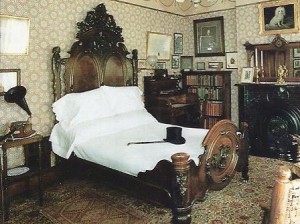 The hat and cane on the bed? They belonged to James, artfully placed in the authentically preserved James Whitcomb Riley Museum House in historic Lockerbie Square. You can see them when you tour the house, along with his writing desk, the study where he sat to read, the dining room where he took his meals, and the parlor where he entertained. A school group was touring when I was there; fourth-graders enjoying the poems and stories of a time gone by, still current in the heart. Read more about James and the classroom programs offered @ http://www.rileykids.org/about/riley_museum/
The hat and cane on the bed? They belonged to James, artfully placed in the authentically preserved James Whitcomb Riley Museum House in historic Lockerbie Square. You can see them when you tour the house, along with his writing desk, the study where he sat to read, the dining room where he took his meals, and the parlor where he entertained. A school group was touring when I was there; fourth-graders enjoying the poems and stories of a time gone by, still current in the heart. Read more about James and the classroom programs offered @ http://www.rileykids.org/about/riley_museum/
